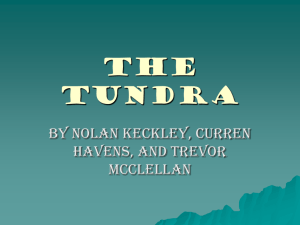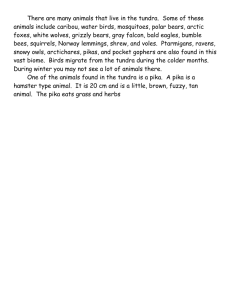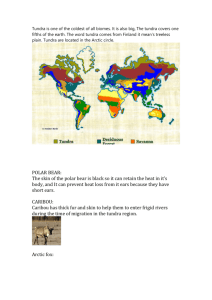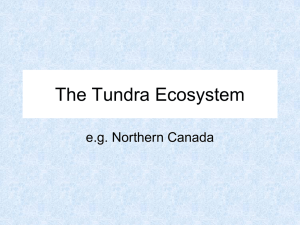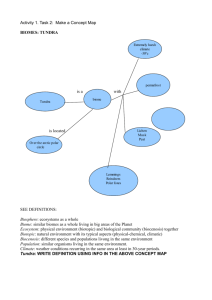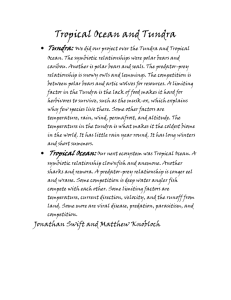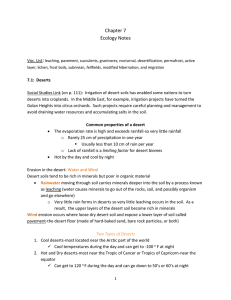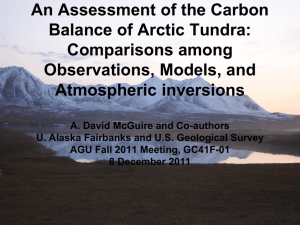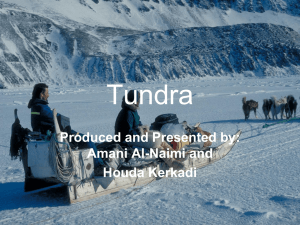The Arctic Tundra
advertisement
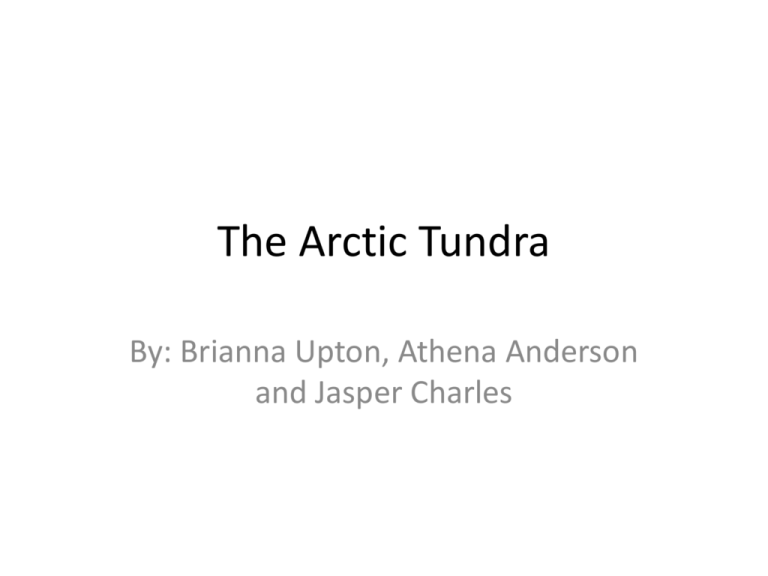
The Arctic Tundra By: Brianna Upton, Athena Anderson and Jasper Charles Tundra Weather • • • • • Extremely low temps. Summer: 37-54 degrees F. Winter: Average of 30 degrees F. Cold dessert like conditions. Only 6-10 inches of rain a year, including melted snow. • White outs happen occasionally. Plant Life in the Tundra • Growing season only last 50 – 60 days. • Plants grow close to the ground and close together for heat. • Lichen is a common fungus found on the rocks, Caribou and Oxen love to eat it. • Many plants have dark red leaves to attract sunlight. • Shrubs can grow when soil accumulates between rocks. Plants Life Cont. • 1,700 + kinds of plants in the Arctic. • All plants are adapted to harsh winds and hard and poor nutrition soil. • The plants can carry out photosynthesis in low light and low temps. • There are no deep root systems because the soil is lacking nutrients and the second layer is completely frozen. Zoology: Arctic Fox • Arctic fox: Scavenger follows the polar bears in hopes finding food. • Weight: 12-6 lbs. • Length: between 10-16 inches long. • Description: short legs, bushy tail, fur is white during the winter and a blue gray color in summer. Zoology: Caribou • Caribou: 5 million caribou(estimate) herbivore. • Weight: bulls- avg. 350-400 lbs. females- 175- 225 • Height: 34-55. • Description: short legs, brown fur, hooves support the animal in the winter and marshy tundra in the summer. • Can travel up to 50 miles a day. Zoology: Polar Bears • Polar bears: carnivores. • Weight: females- 660770 lbs. and males880-990 lbs. • Height: 8-11 ft. • Description: black nose and eyes, two layers of fur, white fur, black rubbery skin. Geography of the Tundra • Covers 1/5 of the worlds surface. • Cold, treeless area, worlds coldest Biome. • In Greenland, Alaska, Northern Russia and Canada have a Tundra. • Tundra is a Finnish word meaning “treeless plain”. • Permafrost layer of soil never thaws. • No deep root system, but water is absorbed to provide moisture for plant life. Human Influences • Arctic: The human influence would be Pollution. There is an oil development near breeding grounds of the Siberian Crane pollutes the wetlands. Disturbance to birds nesting grounds, people move in, making the animals move out. Hunting of birds in the area. Lead shot poisoning. Hunters shoot these shots and then later found in the bottom of water bodies and waterfowls. Picture Citations • http://www.scientificamerican.com/media/inl ine/no-polar-bear-climate-regulation_1.jpg • http://upload.wikimedia.org/wikipedia/comm ons/f/fd/Caribou.jpg • http://www.anwr.org/gallery/images/08Arctic%20Fox.jpg Bibliography • http://www.ucmp.berkeley.edu/exhibits/biom es/tundra.php • http://www.mbgnet.net/ • http://www.kidcyber.com.au/topics/biometun dra.htm • http://www.enchantedlearning.com/biomes/t undra/tundra.shtml Bibliography Cont. • http://www.beaconschool.org/~edugan/tundr alocation.html • http://library.thinkquest.org/C0113340/main. php?section=biomes&topic=tundra&subtopic =location • http://www.birdlife.org/action/science/specie s/asia_strategy/pdf_downloads/wetlandsWO1 .pdf

